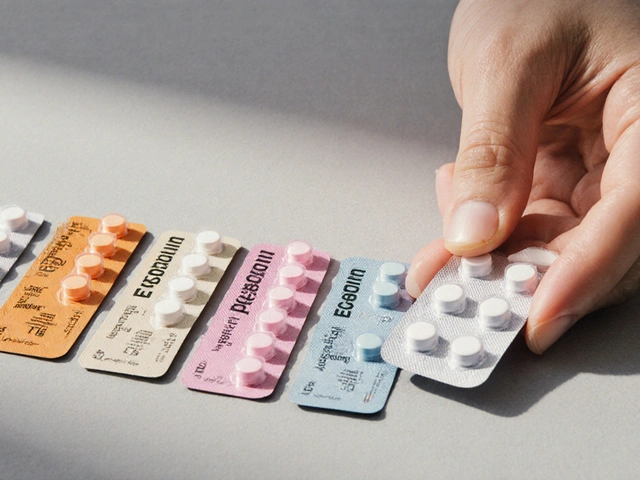TL;DR
- Hormonal swings, especially lower estrogen, push hair into the shedding phase.
- Telogen effluvium and female‑pattern thinning are the two most common patterns.
- Blood‑test screening for iron, thyroid and hormone levels helps pinpoint the root cause.
- Topical minoxidil, low‑dose HRT and targeted nutrition restore density for most women.
- Gentle styling, stress management and scalp care prevent further loss.
Menopause is a natural physiological transition that marks the end of monthly ovulation, typically occurring between ages 45‑55. During this stage, the ovaries dramatically reduce production of estrogen and progesterone, leading to a cascade of systemic effects.
One noticeable side‑effect, often overlooked in routine check‑ups, is hair loss (medical term alopecia), specifically the type linked to hormonal change. While men often associate thinning with genetics, women experience a distinct pattern driven by the endocrine shift.
Why Hormones Matter
The drop in estrogen is the catalyst. Estrogen normally prolongs the hair‑growth (anagen) phase and counteracts the effects of androgen, a hormone that can miniaturise follicles. When estrogen wanes, the protective buffer disappears, allowing even baseline androgen levels to exert a stronger influence.
This hormonal imbalance often manifests as two clinical patterns:
- Telogen effluvium - a diffuse shedding where a larger proportion of hairs enter the resting (telogen) phase simultaneously.
- Female pattern hair loss (FPHL) - a progressive thinning over the crown while the frontal hairline remains largely intact.
Beyond Hormones: Hidden Triggers
Hormone shifts rarely act in isolation. Several secondary factors amplify the problem:
- Iron deficiency: Low ferritin levels reduce the oxygen supply to follicles, worsening telogen effluvium.
- Thyroid dysfunction: Both hypo‑ and hyper‑thyroidism can disrupt the hair growth cycle.
- Vitamin D insufficiency: Vitamin D receptors are present on dermal papilla cells; deficiency hampers follicle renewal.
- Stress: Elevated cortisol spikes can push hairs into the telogen phase, a phenomenon known as stress‑induced effluvium.
Because these contributors often coexist, a comprehensive evaluation is essential before jumping to treatment.
How Clinicians Diagnose Menopause‑Related Hair Loss
- Medical history review - focus on menstrual changes, menopausal symptoms, diet and stress levels.
- Physical scalp examination - assesses pattern, density and any signs of inflammation.
- Blood work - includes complete blood count, ferritin, thyroid‑stimulating hormone (TSH), 25‑OH vitamin D, and a hormone panel (estradiol, testosterone, DHT).
- Pull test - gently tug a small bunch of hair to gauge the proportion of telogen hairs.
These steps help differentiate telogen effluvium (usually sudden and reversible) from FPHL (progressive and often requiring long‑term management).
Evidence‑Based Treatment Options
Below is a side‑by‑side comparison of the most frequently recommended interventions. The data pulls from the British Association of Dermatologists, recent randomized trials, and the Menopause Society’s 2024 guidelines.
| Treatment | Mechanism | Average Efficacy | Common Side‑Effects | Typical Use |
|---|---|---|---|---|
| Hormone Replacement Therapy | Restores systemic estrogen levels, re‑balancing follicle cycle. | 30‑45% reported reduction in shedding after 6months. | Breast tenderness, mild weight gain, rare clotting risk. | Low‑dose oral or transdermal estradiol, often combined with progesterone. |
| Minoxidil | Vasodilator that prolongs anagen phase and enlarges miniaturised follicles. | 25‑35% increase in hair count after 12weeks (2% solution). | Scalp irritation, transient shedding, rare hypertrichosis. | Topical twice daily to affected scalp. |
| Nutritional Supplementation | Addresses iron, vitamin D, biotin, zinc deficits that impede follicle metabolism. | 10‑20% improvement when documented deficiency is corrected. | Gastro‑intestinal upset (high iron), rare allergic reactions. | Oral daily; dosing based on lab‑guided levels. |
| Low‑Level Laser Therapy (LLLT) | Photobiomodulation stimulates mitochondrial activity, promoting hair‑shaft production. | 15‑25% increase in density after 6months of twice‑weekly sessions. | Minimal - occasional scalp warmth. | Hand‑held laser comb or in‑clinic caps. |

Putting It All Together: A Practical Management Plan
- Confirm the diagnosis. Run the blood panel outlined above. If iron or thyroid is off, correct it first - this alone can stop shedding.
- Address lifestyle drivers. Adopt a Mediterranean‑style diet rich in leafy greens, oily fish and legumes; aim for 150g protein daily. Prioritise 7‑8hours sleep and mindfulness or yoga to curb cortisol spikes.
- Start targeted therapy. For most women, a low‑dose transdermal HRT combined with 2% minoxidil gives the fastest visible benefit. If HRT is contraindicated (e.g., history of estrogen‑sensitive cancer), lean on minoxidil plus supplementation.
- Monitor progress. Take serial photographs every 4weeks. If shedding persists beyond 3months, reassess hormone levels and consider adding LLLT.
- Consider cosmetic camouflaging. Volumising powders, strategic braiding or short layered cuts can mask early thinning while medical treatments take effect.
Remember, hair growth is slow - a full growth cycle spans 3‑4months. Patience paired with consistent treatment is key.
Related Concepts to Explore Next
If you found this overview helpful, you might also be interested in deeper dives on:
- The impact of stress‑induced cortisol spikes on overall menopausal wellbeing.
- How vitamin D metabolism interacts with bone health during menopause.
- Comparing synthetic vs bioidentical HRT formulations.
- Emerging scalp‑microneedling protocols for enhancing minoxidil absorption.
Bottom Line
Menopause doesn’t have to mean surrendering your hair. By understanding the hormonal cascade, ruling out nutritional and endocrine roadblocks, and selecting evidence‑based therapies, the majority of women can halt shedding and regain a healthier volume. The journey is personal - work with a clinician who respects both the science and your quality‑of‑life goals.
Frequently Asked Questions
Can menopause cause sudden hair loss?
Yes. The abrupt drop in estrogen can trigger telogen effluvium, a diffuse shedding that often peaks 2‑3months after hormonal change. It’s usually reversible once the underlying cause is addressed.
Is minoxidil safe for women in their 50s?
Topical minoxidil 2% is FDA‑approved for female pattern hair loss and is widely used in menopause‑related cases. Most side‑effects are mild scalp irritation; a brief initial shedding phase is common and resolves within weeks.
Do I need hormone replacement therapy to stop hair loss?
HRT can be very effective, especially when low estrogen is the primary driver. However, it isn’t mandatory - many women achieve good results with minoxidil, iron optimisation and lifestyle changes. Discuss risks with your GP, especially if you have a history of breast or uterine cancer.
What lab tests are most useful?
A basic menopause panel should include serum ferritin, TSH, free T4, 25‑OH vitamin D, estradiol, total testosterone and DHT. If any result is abnormal, targeted supplementation or endocrine referral is advised.
Can dietary changes reverse hair loss?
A nutrient‑dense diet alone seldom restores lost hair, but correcting deficiencies (iron, zinc, vitamin D, biotin) can stop further shedding and support regrowth when combined with other therapies.






12 Comments
Lolita Rosa
September 27, 2025 AT 14:26 PMWow, the sheer roller‑coaster of hormones during menopause can feel like a theatrical tragedy, especially when strands start to vanish like stage props.
Matthew Platts
October 3, 2025 AT 16:00 PMHang in there, you’ve got a solid plan with HRT and minoxidil, sticking to the routine will pay off and the hair will bounce back.
Bernard Williams
October 9, 2025 AT 10:53 AMFrom a clinical standpoint, iron deficiency is often the silent culprit; checking ferritin levels first can save a lot of unnecessary treatments.
Michelle Morrison
October 15, 2025 AT 05:46 AMIt is evident that the mainstream medical narrative obfuscates the true etiology, while covert pharmaco‑industrial interests manipulate data to perpetuate dependence.
harold dixon
October 21, 2025 AT 00:40 AMI appreciate the thorough breakdown, especially the emphasis on lifestyle adjustments; a Mediterranean diet coupled with mindfulness can truly mitigate cortisol spikes.
Consistent sleep hygiene also plays a pivotal role in stabilizing hormonal fluctuations.
Darrin Taylor
October 26, 2025 AT 18:33 PMWhile most clinicians push HRT as a cure‑all, many overlook the potential of natural adaptogens that modulate the endocrine axis without synthetic hormones.
Anthony MEMENTO
November 1, 2025 AT 13:26 PMlook at the data minoxidil works for a good chunk of women but the side effects are often downplayed many patients report scalp irritation and initial shedding which can be misinterpreted as treatment failure the key is patience and consistent application
NANDKUMAR Kamble
November 7, 2025 AT 08:20 AMThe shadowy syndicates behind big‑pharma love to hide the fact that they fund most of the “research” that glorifies synthetic hormones over simple nutrition.
namrata srivastava
November 13, 2025 AT 03:13 AMUtilizing a biomechanical approach to follicular angiogenesis via photobiomodulation can synergistically enhance mitochondrial ATP synthesis within dermal papillae.
Priyanka arya
November 18, 2025 AT 22:06 PMTotally vibing with the laser comb hype 🚀💁♀️
Loren Kleinman
November 24, 2025 AT 17:00 PMMenopause undeniably reshapes many aspects of a woman's physiology.
One of the most visible signs is the alteration in hair density.
The decline of estrogen removes a protective shield that normally lengthens the growth phase of each strand.
Consequently, more hairs enter the resting stage at the same time.
This shift is often compounded by iron or thyroid irregularities that many overlook.
A comprehensive blood panel can pinpoint these hidden factors before any medication is prescribed.
Addressing a ferritin deficiency alone can halt the shedding in a significant number of cases.
Likewise, normalizing thyroid hormones restores the delicate balance required for steady follicle activity.
When hormonal and nutritional issues are corrected, topical minoxidil becomes far more effective.
The vasodilatory action of minoxidil prolongs the anagen phase, allowing follicles to produce thicker fibers.
Low‑dose transdermal estrogen further supports this process by re‑establishing the estrogen‑androgen equilibrium.
Lifestyle interventions such as regular exercise, stress reduction, and adequate sleep reinforce these medical measures.
Exercise improves circulation to the scalp, delivering essential nutrients to the follicles.
Stress management lowers cortisol, which otherwise pushes hair prematurely into the shedding phase.
Patience remains essential because hair cycles span months and visible regrowth takes time.
Sabrina Goethals
November 30, 2025 AT 11:53 AMI kinda think this is super helpful!!! lol